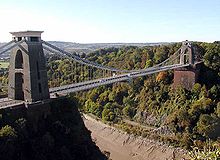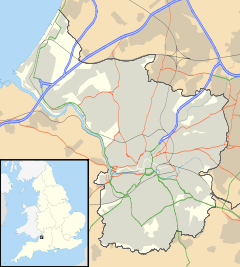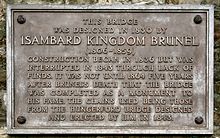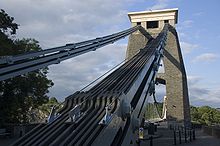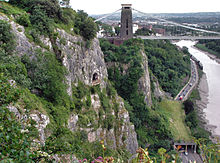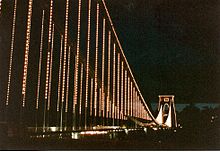- Clifton Suspension Bridge
-
Clifton Suspension Bridge 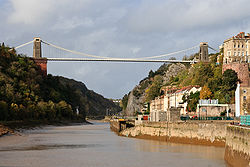
Clifton suspension bridge.Carries Cars, pedestrians and cycles Crosses River Avon Locale Bristol Maintained by Clifton Suspension Bridge Trust Design Suspension bridge Total length 1,352 ft (412 m) Width 31 ft (9.4 m) Longest span 702 ft 3 in (214.05 m) Clearance below 245 ft (75 m) above high water level Opened 1864 Toll Vehicles £0.50 Daily traffic 8,800[1] Coordinates 51°27′18″N 2°37′40″W / 51.4549°N 2.6279°W The Clifton Suspension Bridge is a suspension bridge spanning the Avon Gorge, and linking Clifton in Bristol to Leigh Woods in North Somerset, England. Designed by Isambard Kingdom Brunel, it is a landmark that is used as a symbol of Bristol. It is a grade I listed building.[2] It is classified as a part of the B3129.
The idea of building a bridge across the Avon Gorge originated in 1753 originally for a stone bridge with later plans for a cast iron structure. An attempt to build Brunel's design in 1831 was stopped by the Bristol Riots, and the revised version of his designs was built after his death, being completed in 1864. Although similar in size, the bridge towers are not identical in design, the Clifton tower having side cut-outs, the Leigh tower more pointed arches atop a 110 feet (34 m) red sandstone clad abutment. Roller mounted "saddles" at the top of each tower allow movement of the three independent wrought iron chains on each side when loads pass over the bridge. The bridge deck is suspended by eighty-one matching vertical wrought-iron rods.
Two men were killed during the construction of the bridge; since opening it had a reputation as a suicide bridge. It now has plaques that advertise the telephone number of The Samaritans and has anti-climb barriers above the railings on the bridge.
The bridge is a distinctive landmark, used as a symbol of Bristol on postcards, promotional materials, and informational web sites. It has also been used as a backdrop to several films and television programmes.
Contents
History
The idea of building a bridge across the Avon Gorge originated in 1753, with a bequest in the will of Bristolian merchant William Vick, who left £1,000 invested with instructions that when the interest had accumulated to £10,000, it should be used for the purpose of building a stone bridge between Clifton Down (which was in Gloucestershire, outside the City of Bristol, until the 1830s) and Leigh Woods in Somerset.[3]
By 1829, Vick's bequest had reached £8,000, but it was estimated that a stone bridge would cost over ten times that amount. An Act of Parliament was passed to allow a wrought iron suspension bridge to be built instead, and tolls levied to recoup the cost. A competition was held to find a design for the bridge; the judge, Thomas Telford, rejected all designs, and tried to insist on a design of his own, a suspension bridge supported on tall Gothic towers.[3] Telford claimed that no suspension bridge could exceed the 577 feet (176 m) span of his own Menai Suspension Bridge. A second competition, held with new judges, was won by Brunel's design on 16 March 1831, for a suspension bridge with fashionably Egyptian-influenced towers.[3]
An attempt to build Brunel's design in 1831 was stopped by the Bristol Riots, which severely dented commercial confidence in Bristol.[4] Work was not started again until 1836, and thereafter the capital from Vick's bequest and subsequent investment proved woefully inadequate. By 1843, the towers had been built in unfinished stone, but funds were exhausted. In 1851, the ironwork was sold and used to build the Brunel-designed Royal Albert Bridge on the railway between Plymouth and Saltash.[5]
Coordinates: 51°27′18″N 2°37′40″W / 51.4549°N 2.6279°W
Brunel died in 1859, without seeing the completion of the bridge. Brunel's colleagues in the Institution of Civil Engineers felt that completion of the Bridge would be a fitting memorial, and started to raise new funds. In 1860, Brunel's Hungerford suspension bridge, over the Thames in London, was demolished to make way for a new railway bridge to Charing Cross railway station, and its chains were purchased for use at Clifton. A slightly revised design was made by William Henry Barlow and Sir John Hawkshaw; it has a wider, higher and sturdier deck than Brunel intended, triple chains instead of double, and the towers were left as rough stone rather than being finished in Egyptian style. Work on the bridge was restarted in 1862, and was complete by 1864.[6]
The bridge is now managed by a trust set up by Act of Parliament in 1952. A toll of £0.50 is levied on vehicles, but the £0.05 toll that the Act allows for cyclists or pedestrians is not collected.[7]
The first modern bungee jumps were made on 1 April 1979 from the bridge, by members of the Oxford University Dangerous Sports Club.[8]
In 2003, the weight of crowds travelling to and from the Ashton Court festival and Bristol International Balloon Fiesta put such great strain on the bridge that it was decided to close the bridge to all traffic, including pedestrians, during the whole of the Ashton Court Festival and part of the Balloon Fiesta in 2004. The closure of the bridge for major annual events has continued each year since then.[9]
On 26 November 2003, the last ever Concorde flight (Concorde 216) flew over the bridge before landing at Filton Aerodrome.[10] It was a symbolic moment which commemorated Bristol's feats in engineering.
In April 2006, the bridge was the centrepiece of the Brunel 200 weekend, celebrating the 200th anniversary of the birth of Isambard Kingdom Brunel. At the climax of the celebration a firework display was launched from the bridge.[11] The celebrations also saw the switch on of an LED-based lighting array to illuminate the bridge.[12]
On 4 April 2009, the bridge was shut overnight due to a crack in one of the support hangers.[13]
In November 2011 it was announced that a new visitor centre, costing nearly £2 million, was to be built at the Leigh Woods end of the bridge to replace the temporary building currently being used. The new facilities are scheduled to be completed before the 150th anniversary of the opening which will be celebrated on 8 December 2014.[14][15]
Engineering
Although similar in size, the bridge towers are not identical in design, the Clifton tower having side cut-outs, the Leigh tower more pointed arches. Brunel's original plan proposed they be topped with then-fashionable sphinxes, but the ornaments were never constructed.[16]
The 85 ft (26 m) tall Leigh Woods tower stands atop a 110 feet (34 m) red sandstone clad abutment. In 2002 it was discovered that this was not a solid structure but contained 12 vaulted chambers up to 35 feet (11 m) high, linked by shafts and tunnels.[17]
Roller mounted "saddles" at the top of each tower allow movement of the chains when loads pass over the bridge. Though their total travel is minuscule, their ability to absorb forces created by chain deflection prevents damage to both tower and chain.[16][17]
The bridge has three independent wrought iron chains per side, from which the bridge deck is suspended by eighty-one matching vertical wrought-iron rods ranging from 65 feet (20 m) at the ends to 3 feet (0.91 m) in the centre.[18] Composed of numerous parallel rows of eyebars connected by bolts, the chains are anchored in tunnels in the rocks 60 feet (18 m) below ground level at the sides of the gorge.[17] The deck was originally laid with wooden planking, later covered with asphalt, which was renewed in 2009.[17]
The weight of the bridge, including chains, rods, girders and deck is approximately 1,500 tons.[19]
Dimensions
- Span: 702 ft 3 in (214.05 m)[20]
- Height of towers: 86 feet (26 m) above deck[20]
- Tower Width: 11 feet (3.4 m)
- Clearance: 245 feet (75 m) above high water level[20]
- Traffic: Four million vehicles per year[21]
- Overall Width: 31 ft (9.45 m)[22]
- Dip of Chains: 70 ft (21.34 m)
Suicides and accidents
Two men were killed during the construction of the bridge.[19] In 1885, a 22-year-old woman named Sarah Ann Henley survived a fall from the bridge when her billowing skirts acted as a parachute; she subsequently lived into her eighties.[19]
The Clifton Suspension Bridge is well known as a suicide bridge and is fitted with plaques that advertise the telephone number of The Samaritans. Between 1974 and 1993, 127 people fell to their deaths from the bridge.[23] In 1998 barriers were installed on the bridge to prevent people jumping. In the four years after installation this reduced the suicide rate from eight deaths per year to four.[24] Nicolette Powell, the wife of singer Georgie Fame, formerly the Marchioness of Londonderry, committed suicide from the bridge on 13 August 1993.[25]
Although flying under the bridge has been outlawed since 1911, in 1957 a Filton-based RAF Vampire jet from 501 Squadron flew at high speed under the deck before crashing in Leigh Woods, killing the pilot.[26] A police helicopter flew under the bridge during a search in 1997.[19]
Popular culture
The bridge is a distinctive landmark, used as a symbol of Bristol on postcards, promotional materials, and informational web sites such as Visit Bristol.[27] BBC West uses a clip of the bridge in their opening titles for their regional news programme BBC Points West which serves the West TV region.[28] The bridge is also used as a backdrop on The West Country Tonight - a regional news programme broadcast by ITV West from their Bristol studios.[29]
Construction of the bridge was featured in the Channel 4 television series The Worst Jobs in History,[30] as part of an episode entitled The Worst Industrial Jobs in History, first broadcast on 7 May 2006.[31]
In 2011, the bridge featured in the BBC2 programme "Climbing Great Buildings" - when Dr Jonathan Foyle and Lucy Creamer climbed the bridge and went into the bridge supports.[32]
References
- ^ "Suspension bridge toll may double to £1". Bristol Evening Post. 12 November 2010. http://www.thisisbristol.co.uk/news/Suspension-bridge-toll-double-163-1/article-2882722-detail/article.html. Retrieved 13 November 2010.
- ^ "Clifton Suspension Bridge". Images of England. English Heritage. http://www.imagesofengland.org.uk/details/default.aspx?id=379208. Retrieved 9 May 2006.
- ^ a b c Vaughan, Adrian: Isambard Kingdom Brunel — Engineering Knight Errant, John Murray, 1991, ISBN 0-7195-5748-8.[page needed]
- ^ "Revolting riots in Queen Square". BBC Bristol. BBC. http://www.bbc.co.uk/bristol/content/madeinbristol/2004/04/riot/riot.shtml. Retrieved 3 July 2011.
- ^ "Royal Albert Bridge, Saltash". Engineering Timelines. http://www.engineering-timelines.com/scripts/engineeringItem.asp?id=210. Retrieved 3 July 2011.
- ^ "Clifton Suspension Bridge". Engineering Timelines. http://www.engineering-timelines.com/scripts/engineeringItem.asp?id=58. Retrieved 3 July 2011.
- ^ "How much is the toll to cross the Bridge?". Clifton Suspension Bridge. http://www.cliftonbridge.org.uk/faqs/toll. Retrieved 3 July 2011.
- ^ "History of Bungee". Aerial Extreme Sports. 2008. http://library.thinkquest.org/C0123122/historybungee.htm. Retrieved 5 July 2011.
- ^ "Suspension bridge shut for events". BBC News. 29 June 2005. http://news.bbc.co.uk/1/hi/england/bristol/4633715.stm. Retrieved 25 March 2007.
- ^ "The Last Flight Home". Aviation Art. http://www.avcollect.com/art_sb_concorde5.html. Retrieved 3 July 2011.
- ^ "Brunel 200 Fireworks". BBC Bristol. http://www.bbc.co.uk/bristol/content/image_galleries/brunel_fireworks_april_gallery.shtml. Retrieved 25 March 2007.
- ^ "LEDs help to light Clifton Suspension Bridge". LEDs magazine. http://www.ledsmagazine.com/features/3/4/3. Retrieved 17 May 2007.
- ^ "Suspension bridge closed by fault". BBC. 4 April 2009. http://news.bbc.co.uk/1/hi/england/bristol/7983615.stm. Retrieved 4 April 2009.
- ^ "New heritage and learning centre". Clifton Suspension Bridge. http://www.cliftonbridge.org.uk/news/new-heritage-and-learning-centre-clifton-suspension-bridge-will-mark-150th-anniversary-official. Retrieved 8 November 2011.
- ^ "New Clifton Suspension Bridge visitor centre planned". BBC. 8 November 2011. http://www.bbc.co.uk/news/uk-england-bristol-15634015. Retrieved 8 November 2011.
- ^ a b "Clifton Suspension Bridge". Farvis. http://www.farvis.com/bridge,htm.htm. Retrieved 17 May 2007.
- ^ "Clifton Suspension Bridge". Brantacan. http://www.brantacan.co.uk/cliftonsb.htm. Retrieved 17 May 2007.
- ^ a b c d "Suspension Bridge Frequently Asked Questions". Clifton Suspension Bridge Trust. http://www.cliftonbridge.org.uk/faqs/lady_survived_fall. Retrieved 3 July 2011.
- ^ a b c "Clifton Suspension Bridge". Structurae. http://en.structurae.de/structures/data/index.cfm?ID=s0000018. Retrieved 3 July 2011.
- ^ "Clifton Suspension Bridge". Teachers Domain. http://www.teachersdomain.org/resource/phy03.sci.phys.mfw.bbsuspension/. Retrieved 22 March 2009.
- ^ "What are the dimensions of the Clifton Suspension Bridge?". Clifton Suspension Bridge Trust. http://www.cliftonbridge.org.uk/faqs/dimensions. Retrieved 3 July 2011.
- ^ Nowers, M; Gunnell, D (1996). "Suicide from the Clifton Suspension Bridge in England". Journal of Epidemiology and Community Health 50 (1): 30–2. doi:10.1136/jech.50.1.30. PMC 1060200. PMID 8762350. http://jech.bmj.com/cgi/content/abstract/50/1/30. Retrieved 25 March 2007.
- ^ Bennewith, O; Nowers, M; Gunnell, D (2007). "Effect of barriers on the Clifton suspension bridge". The British Journal of Psychiatry 190 (3): 266–7. doi:10.1192/bjp.bp.106.027136. PMID 17329749. http://bjp.rcpsych.org/cgi/content/abstract/190/3/266. Retrieved 25 March 2007.
- ^ Hoggard, Liz (24 September 2006). "High Society: Whatever happened to the last of the debs?". The Independent. http://www.independent.co.uk/news/uk/this-britain/high-society-whatever-happened-to-the-last-of-the-debs-417273.html. Retrieved 13 February 2009.
- ^ Giles Whittell (2007). Spitfire Women of World War II. Harper Perennial. pp. 151. ISBN 978-0-00-723536.
- ^ "Visit Bristol". http://visitbristol.co.uk/. Retrieved 16 May 2007.
- ^ "BBC West News". TV Ark. http://www2.tv-ark.org.uk/bbc_west/news.html. Retrieved 5 July 2011.
- ^ "The West Country Tonight Backdrop". ITV West. http://1.bp.blogspot.com/_khnBA58ed2k/SjDuqTZtArI/AAAAAAAAHQw/P59u7hZ1diw/s400/eb2.JPG.
- ^ "Victorian Jobs: Bridge Builder". The Worst Jobs in History microsite. Channel 4. http://www.channel4.com/history/microsites/W/worstjobs/credits.html. Retrieved 20 January 2008.
- ^ "Episode Guide: The Worst Industrial Jobs in History". Internet Movie Database. http://imdb.com/title/tt0795036/. Retrieved 20 January 2008.
- ^ BBC2
External links
- Official website
- 'Brunel 200 Weekend' provided by BBC Bristol
- Clifton Suspension Bridge at www.ikbrunel.org.uk
- Time-lapse video showing the bridge as the tide changes and night time arrives on YouTube
- Clifton Suspension Bridge Trust papers, 1829-1939 University of Bristol Library Special Collections
- 1953 newsreel of Clifton Suspension Bridge
Great Western Railway · Wharncliffe Viaduct · Maidenhead Bridge · Windsor Bridge · Chepstow Bridge · Royal Albert Bridge · Box Tunnel
Thames Tunnel · Atmospheric railway · South Devon Railway sea wall · Hungerford Bridge · Clifton Suspension Bridge
SS Great Western· SS Great Britain · SS Great Eastern · Other works of BrunelSevern Bridge · Menai Suspension Bridge · Forth Road Bridge · Humber Bridge · Tamar Bridge · Clifton Suspension Bridge · Union Bridge · Queen Elizabeth II BridgeTransport in Bristol Road Motorways European Routes A roads Bus Buses in Bristol · Bristol Bus Station · Bristol Portway park and ride · Bristol A4 Bath Road park and ride · Bugler Coaches · First Bristol · First Somerset & Avon · Wessex Red · List of bus routes in BristolCycling Rail Railway lines Stations Avonmouth · Bedminster · Bristol Parkway · Bristol Temple Meads · Clifton Down · Lawrence Hill · Montpelier · Parson Street · Portway · Redland · Sea Mills · Severn Beach · Shirehampton · St Andrews Road · Stapleton RoadOther Greater Bristol MetroAir Waterways River Avon · Bristol Harbour · Cumberland Basin · Netham Lock · Bristol Ferry Boat Company · Bristol Marina · Underfall Yard · Kennet and Avon CanalSea Public Transport Bridges Categories:- Visitor attractions in Bristol
- Bridges in Somerset
- Bridges in Bristol
- Bridges completed in 1864
- Suspension bridges in the United Kingdom
- Toll bridges in the United Kingdom
- Grade I listed buildings in Bristol
- Grade I listed buildings in Somerset
- Grade I listed bridges
- Bridges of Isambard Kingdom Brunel
- Buildings and structures in North Somerset
- Clifton, Bristol
Wikimedia Foundation. 2010.

